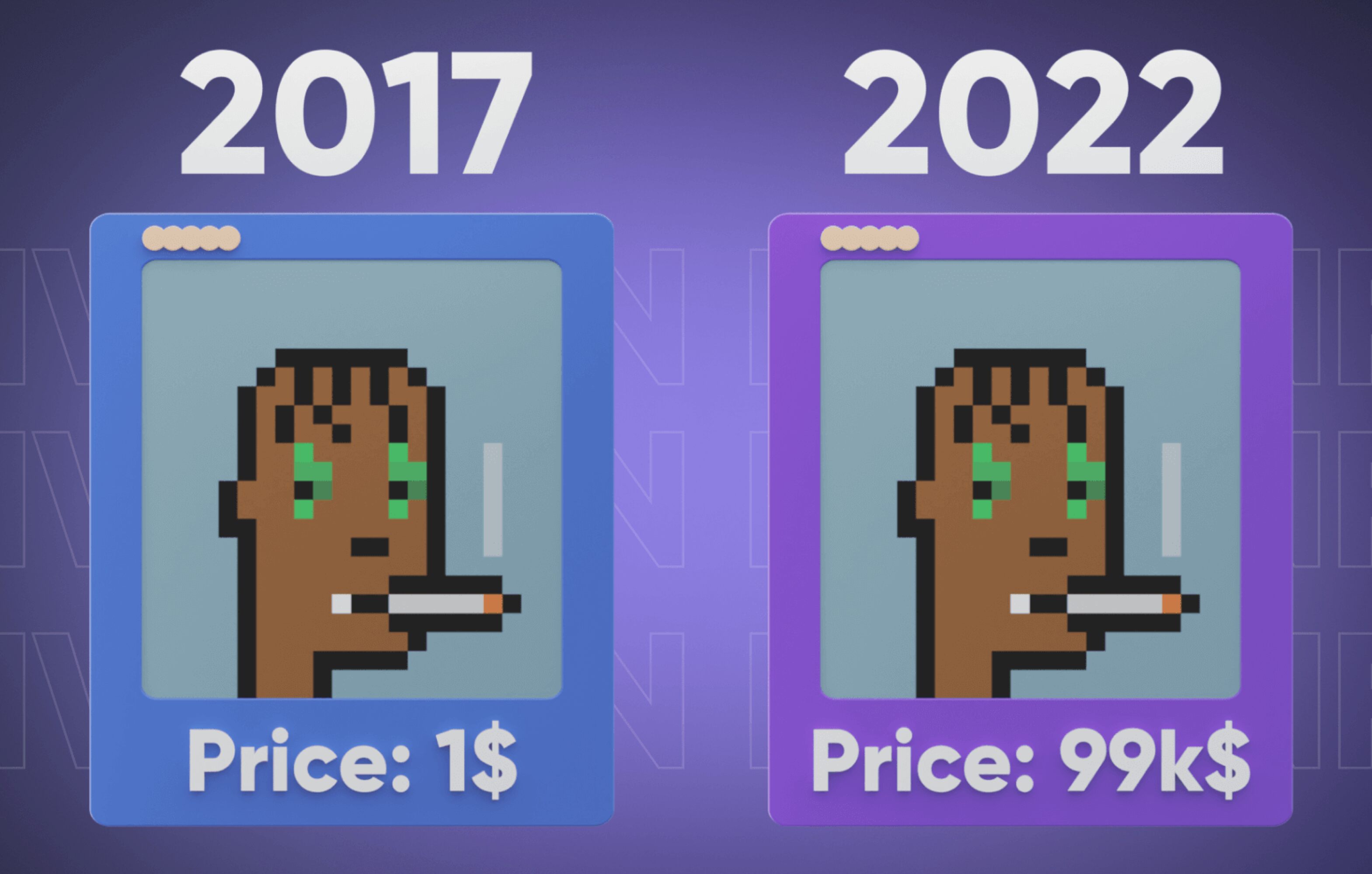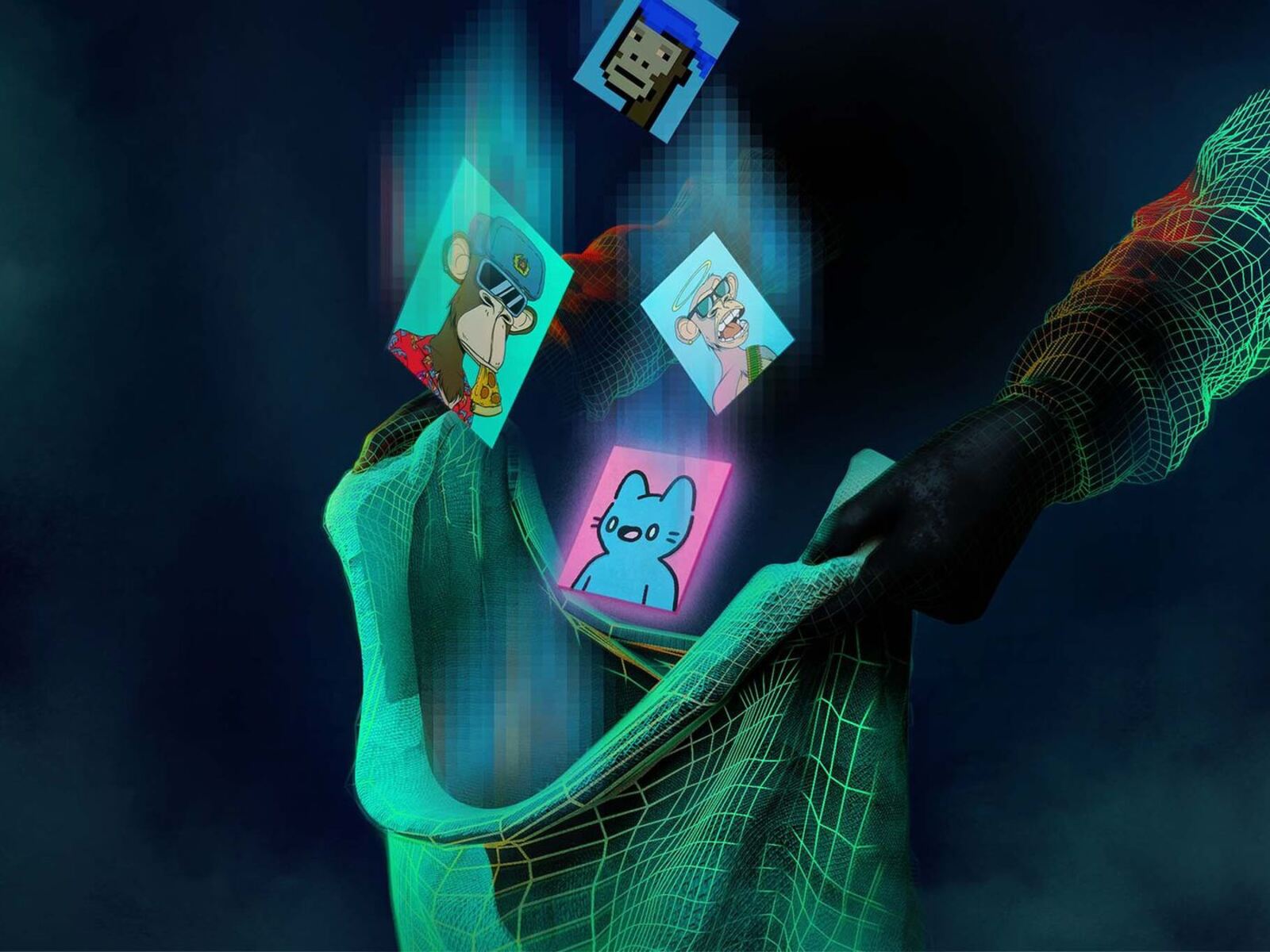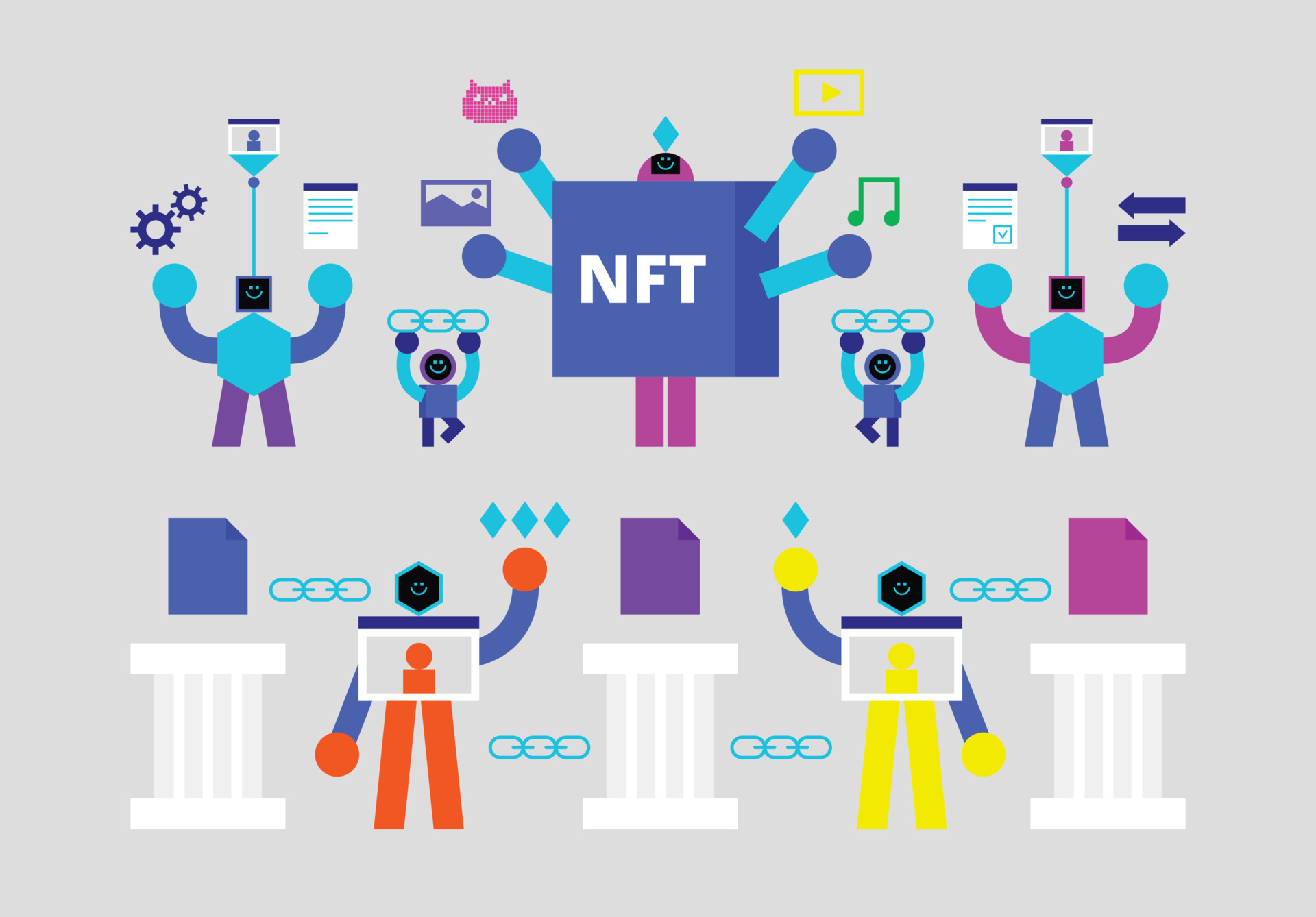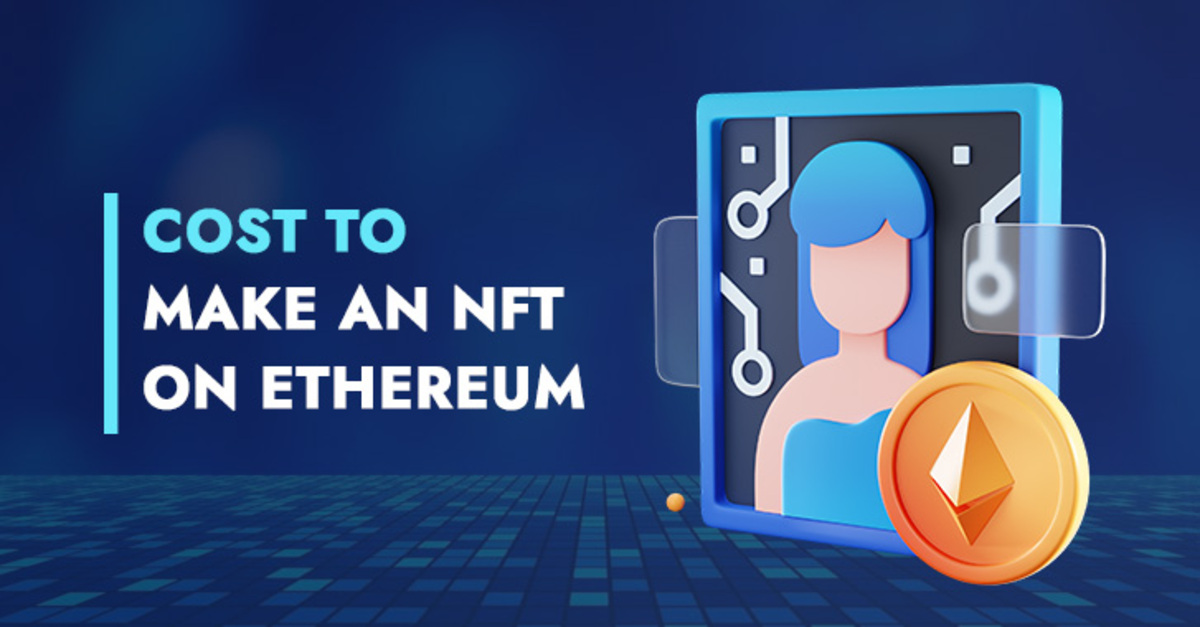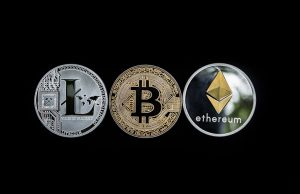Introduction
Welcome to the exciting world of Non-Fungible Tokens (NFTs), where digital assets are transforming the way we create, buy, and sell unique digital items. If you’ve been hearing buzz about NFTs and wondering how people make money from them, you’re in the right place.
In recent years, NFTs have gained massive popularity, sparking a global frenzy of buying and selling digital art, collectibles, virtual real estate, and other unique digital assets. From famous artists and musicians to passionate collectors and enthusiasts, everyone seems to be jumping on the NFT bandwagon.
But what exactly is an NFT? Well, let’s break it down. Unlike cryptocurrencies like Bitcoin or Ethereum, which are fungible and can be exchanged on a one-to-one basis, NFTs are unique digital assets with distinct characteristics that set them apart.
In simplest terms, an NFT represents ownership or proof of authenticity for a specific digital item, such as an artwork, music file, video clip, or virtual object. Each NFT is stored on a blockchain, a decentralized and transparent digital ledger that ensures the asset’s authenticity, traceability, and immutability.
So, how do people make money from NFTs? The answer lies in the inherent value and scarcity of these digital assets. Just like physical art or collectibles, NFTs derive their value from factors such as the creator’s reputation, the uniqueness of the item, and its perceived demand in the market.
While the concept of NFTs might sound complex, the process of creating, buying, and selling them can be relatively straightforward. In this article, we’ll explore the various ways you can profit from NFTs, whether you’re an artist, a collector, or simply intrigued by this emerging digital economy.
Before diving into the details, it’s important to note that the NFT market is still relatively new and rapidly evolving. As with any investment or entrepreneurial endeavor, it’s essential to approach it with caution, do your research, and be aware of the risks involved.
So, if you’re ready to embark on a fascinating journey into the world of NFTs and discover how you can make money from this emerging trend, let’s get started!
What is an NFT?
If you’re new to the world of NFTs, you might be wondering what exactly they are and how they differ from traditional digital assets. Let’s delve into the fascinating realm of NFTs and unravel their unique characteristics.
Non-Fungible Tokens, or NFTs, are digital assets that represent ownership or proof of authenticity for a specific item. Unlike fungible assets such as cryptocurrencies, NFTs are indivisible and unique. Each token holds distinct information that sets it apart from other tokens.
Think of it this way: if cryptocurrencies like Bitcoin or Ethereum are like identical dollar bills, NFTs are like one-of-a-kind pieces of art. While you can exchange dollar bills with each other on a one-to-one basis, each NFT has its own distinct value and cannot be exchanged for another NFT on an equal basis.
One of the key features of NFTs is that they are stored on a blockchain, a decentralized and transparent digital ledger. This ensures the authenticity and ownership of the NFT. Most NFTs are based on the Ethereum blockchain, utilizing its smart contract functionality to store additional information and enable interactions.
NFTs can encapsulate a wide range of digital assets, including artwork, music, videos, virtual real estate, virtual goods, and more. They enable creators and artists to tokenize their work, providing a unique digital representation that can be bought, sold, and owned by collectors.
The value of an NFT is derived from several factors. First and foremost, it is influenced by the perceived value of the underlying digital asset. The reputation and popularity of the creator also play a significant role. Just like in the physical art world, renowned artists or celebrities tend to fetch higher prices for their NFTs.
Scarcity is another crucial aspect. Limited edition NFTs or those associated with a well-known event or series often have higher demand and value. Additionally, the unique features or attributes of an NFT can also impact its value. For example, an NFT with interactive elements or unlockable content may be more desirable to collectors.
Ownership of an NFT grants the buyer certain rights, which can vary depending on the creator’s terms and the platform hosting the NFT. These rights may include the ability to display and resell the NFT, access to additional content or perks tied to the NFT, and potential royalties from subsequent sales.
With a solid understanding of what NFTs are and their unique characteristics, you’re now ready to explore the various ways you can dive into the world of NFTs and start making money from these fascinating digital assets.
Why are NFTs valuable?
NFTs have taken the world by storm, with some selling for jaw-dropping prices. But why are these digital assets so valuable? Let’s explore the factors that contribute to the value of NFTs and why people are willing to invest in them.
1. Uniqueness and Authenticity:
The inherent uniqueness of NFTs sets them apart from other digital assets. Each NFT represents a specific item, whether it’s a piece of artwork, a music file, or a virtual object. This uniqueness is guaranteed by the blockchain, ensuring the authenticity and provenance of the digital asset. Owning an NFT means owning a piece of history, a one-of-a-kind digital creation that cannot be replicated or forged.
2. Rarity and Scarcity:
NFTs can have limited supply, making them inherently scarce. Artists may release only a certain number of editions, creating a sense of exclusivity and increasing the perceived value. Collectors are often willing to pay a premium for rare or limited-edition NFTs, knowing that they possess an item that few others can own.
3. Celebrities and Influencers:
When famous artists, musicians, celebrities, or influencers embrace NFTs, it adds an extra layer of value. The association with a well-known name or brand attracts attention and increases demand for their NFTs. Collectors and fans are often willing to invest in these digital assets as a way to support their favorite artists or to obtain a piece of memorabilia from a notable figure.
4. Potential for Future Value:
One of the key factors driving the value of NFTs is the potential for future appreciation. Just like physical art or collectibles, the value of an NFT can increase over time, especially if the creator gains more recognition or if the NFT becomes a sought-after piece within the digital art community. Investors and collectors are banking on the long-term value of NFTs, hoping that they can sell or trade them for a higher price in the future.
5. Digital Ownership and Display:
With NFTs, owning a digital asset comes with the ability to display it in virtual galleries, social media platforms, or personal websites. This offers a new way of showcasing and sharing digital art or collectibles with a global audience. The ability to exhibit and interact with the NFT adds value and enhances the overall experience for both the creator and the owner.
6. Potential for Royalties:
Unlike traditional art or collectibles, NFTs can include smart contracts that allow creators to earn royalties from subsequent sales. This feature ensures that artists can continue to benefit financially every time their NFT is resold in the secondary market. The potential for ongoing income from resales adds value to the NFT and incentivizes creators to tokenize their work.
By understanding the factors that contribute to the value of NFTs, you can better navigate the market and make informed decisions when buying or selling these digital assets. Whether you’re an artist looking to monetize your creations or a collector interested in investing, the value of NFTs extends beyond their digital nature, revolutionizing the way we perceive and interact with digital art and collectibles.
Creating and Minting NFTs
If you’re an artist or a creator looking to get started with NFTs, the process of creating and minting your own digital assets can be an exciting and rewarding endeavor. Here’s a step-by-step guide on how to create and mint NFTs.
1. Choose your Digital Asset:
First, decide on the digital asset you want to tokenize and turn into an NFT. It could be a piece of artwork, a music file, a video clip, a virtual object, or any other unique digital creation. Ensure that you have the necessary rights and ownership over the asset you’re planning to tokenize.
2. Select an NFT Marketplace:
Next, research and choose a suitable NFT marketplace to mint and sell your NFTs. Popular platforms include OpenSea, Rarible, and Foundation. Each marketplace has its own requirements, fees, and community, so consider factors such as user base, marketplace fees, and ease of use.
3. Create a Digital Wallet:
To interact with NFT marketplaces, you’ll need a cryptocurrency wallet that supports the Ethereum blockchain, such as MetaMask or Trust Wallet. Set up and secure your wallet by following the instructions provided by the wallet provider.
4. Connect your Wallet to the Marketplace:
Link your digital wallet to the NFT marketplace of your choice. This connection enables you to mint and manage your NFTs directly from your wallet. Follow the instructions provided by the marketplace to connect your wallet securely.
5. Prepare and Upload your Digital Asset:
Before minting your NFT, prepare your digital asset according to the requirements of the marketplace. This may include ensuring the correct file type, dimensions, and metadata. Once prepared, upload your digital asset to the marketplace’s platform.
6. Define NFT Details and Attributes:
Provide detailed information and added value to your NFT by filling in relevant details and attributes. This may include the title, description, edition number, artist royalties, unlockable content, and any additional features that make your NFT unique or desirable.
7. Set a Price or Auction:
Decide whether you want to sell your NFT at a fixed price or through an auction. For fixed price sales, set a price in either Ethereum or the marketplace’s native currency. For auctions, specify the starting bid, duration, and any reserve price you might have.
8. Confirm and Mint the NFT:
Review all the details and attributes of your NFT listing, ensuring everything is accurate. Once satisfied, confirm the minting process. This process will create a unique token on the blockchain representing your digital asset.
9. Promote your NFT:
After minting your NFT, it’s time to promote it to potential buyers. Utilize social media platforms, online communities, and your network to spread the word about your NFT. Engage with collectors, art enthusiasts, and other creators to increase visibility and interest in your NFT.
By following these steps, you can unleash your creativity and mint your own NFTs. Remember to stay informed about the marketplace fees, potential gas fees, and the community surrounding each platform. Keep exploring and experimenting as you embark on your NFT journey.
Choosing the Right NFT Marketplace
With the growing popularity of NFTs, numerous marketplaces have emerged, offering platforms for creators to mint and sell their digital assets. When selecting an NFT marketplace, it’s essential to consider various factors that can impact your selling experience and potential earnings. Here are some key considerations to help you choose the right NFT marketplace.
1. User Base and Audience:
Take into account the size and demographics of the marketplace’s user base. Look for a platform that attracts a wide range of collectors, investors, and art enthusiasts who are actively engaging with NFTs. A larger audience increases the potential visibility and demand for your NFTs.
2. Marketplace Fees:
Understand the fee structure of each marketplace. Some platforms charge a commission on each sale, while others have gas fees associated with minting and transaction processing on the blockchain. Compare the fees and consider how they might impact your profitability and the price you set for your NFTs.
3. Platform Reputation and Trust:
Evaluate the reputation and trustworthiness of the marketplace. Research user reviews, testimonials, and feedback from other artists and creators who have used the platform. A reputable marketplace provides a secure environment, transparent policies, and reliable customer support.
4. Ease of Use and Interface:
Consider the user-friendliness and intuitiveness of the marketplace’s interface. A platform with an easy-to-navigate interface and clear instructions simplifies the process of minting and managing your NFTs. This is particularly important for creators who may be less tech-savvy.
5. Additional Features and Tools:
Check for any additional features and tools offered by the marketplace. Some platforms provide features like customizable profiles, analytics and insights, social sharing options, and integration with external services. These features can enhance your ability to market and manage your NFTs effectively.
6. Community and Networking:
Consider the community surrounding the marketplace. Participating in a vibrant community of artists, collectors, and enthusiasts can provide networking opportunities, exposure to collaborations and projects, and valuable insights into the NFT space. Look for platforms that facilitate community interaction and engagement.
7. Flexibility and Customization:
Evaluate the flexibility and customization options provided by the marketplace. Some platforms allow artists to set their own terms, such as royalties on secondary sales or limited editions. Flexibility in pricing, auction options, and ownership rights can contribute to a more personalized and tailored selling experience.
8. Platform Roadmap and Future Development:
Consider the future plans and development roadmap of the marketplace. Look for platforms that are actively evolving, adding new features, and expanding their offerings. Staying on top of market trends and being part of an innovative ecosystem can enhance your long-term success in the NFT space.
By carefully considering these factors, you can select an NFT marketplace that aligns with your goals and maximizes your chances of gaining visibility, attracting buyers, and ultimately monetizing your digital creations. It’s important to regularly reassess your choice based on market shifts and emerging platforms to ensure you are utilizing the best marketplace for your NFTs.
Selling NFTs: Auctions vs. Direct Sales
When it comes to selling your NFTs, you have the option to choose between auctions and direct sales. Each method has its own advantages and considerations, so it’s essential to understand the differences and decide which approach works best for your NFTs and your selling strategy.
Auctions:
Auctions involve setting a starting bid and a duration for potential buyers to place their bids. Here are a few reasons why auctions can be an effective way to sell your NFTs:
1. Competitive Bidding:
An auction format can generate excitement and competition among buyers, potentially driving up the price of your NFT. This is particularly true if your NFT has unique features, limited availability, or if it’s associated with a well-known artist or event.
2. Discovery and Exposure:
An auction can attract a larger audience to your NFT, as potential buyers may be drawn to the opportunity to acquire a highly coveted item. This exposure can lead to more visibility for your NFT and potentially result in a higher selling price.
3. Price Discovery:
Auctions allow the market to determine the value of your NFT. By starting with a lower bid and letting buyers bid against each other, you can discover the true market value of your NFT and potentially achieve a higher price than anticipated.
4. Fostering Engagement:
An auction format encourages buyers to actively participate and engage with your NFT. The bidding process can create a sense of anticipation and involvement, making the buying experience more interactive for potential buyers.
Direct Sales:
Direct sales involve setting a fixed price for your NFT, allowing potential buyers to purchase it at that price. Here are some reasons why direct sales may be the preferred method for selling your NFTs:
1. Fixed Price Certainty:
With direct sales, you have control over the price you want to set for your NFT. This approach provides certainty and transparency for both you and the buyer, eliminating the uncertainty and potential fluctuations associated with auctions.
2. Immediate Transaction:
When selling your NFT through direct sales, the transaction can be completed quickly and seamlessly. Buyers can make an instant purchase without having to wait for the auction duration to end, streamlining the buying process.
3. Bypassing Auction Risks:
Auctions can be unpredictable, and there’s always the possibility that your NFT may not sell for the desired price or that bidding may not reach your expectations. By opting for direct sales, you can avoid these risks and sell your NFT at the price you deem appropriate.
4. Targeted Marketing:
With direct sales, you can focus your marketing efforts on promoting the fixed price of your NFT. This allows you to tailor your messaging and highlight the specific value propositions of your NFT to attract potential buyers more effectively.
When deciding between auctions and direct sales, consider factors such as the demand for your NFT, the uniqueness of the item, your desired selling price, and your overall selling strategy. Some creators may choose to use a combination of both methods to maximize their exposure and potential earnings.
It’s important to note that the NFT market is still evolving, and selling strategies may vary based on trends and best practices. Stay informed, experiment, and adapt your selling approach to best suit the needs and preferences of your target audience.
Pricing Your NFTs
Determining the right price for your NFTs is a crucial aspect of selling your digital assets successfully. The price you set can impact the perceived value of your NFT and ultimately influence its marketability and profitability. Here are some important considerations to help you navigate the process of pricing your NFTs.
Evaluate the Intrinsic Value:
Start by assessing the intrinsic value of your NFT. Consider factors such as the quality, uniqueness, and creativity of your digital asset. Take into account the time, effort, and skill required to create it. If your NFT has special features, interactivity, or unlockable content, these elements can add value and justify a higher price.
Research comparables:
Researching and analyzing similar NFTs in the market can provide valuable insights into the pricing landscape. Look for comparable NFTs in terms of the type of asset, artist reputation, edition number, and other relevant attributes. Examine their selling prices and the demand they generated. This research can help you gauge the competitive pricing range for your NFT.
Consider Supply and Demand:
Supply and demand play a significant role in pricing your NFTs. If your NFT is part of a limited edition or offers exclusive features, it may command a higher price due to its scarcity and desirability. On the other hand, if the market is saturated with similar NFTs or there is low demand for your particular type of asset, this may impact the pricing strategy.
Factor in Artist Reputation and Recognition:
Your reputation as an artist and your standing in the NFT community can influence the perceived value of your NFTs. If you have an established presence, a strong track record, or a dedicated following, potential buyers may be willing to pay a premium for your work. Consider your reputation and visibility when determining the pricing structure.
Experiment and Iterate:
Setting the initial price for your NFT is not set in stone. You have the flexibility to experiment and iterate based on market feedback. If you notice low interest or if your NFT does not sell, you may consider adjusting the price to attract potential buyers. Likewise, if there is high demand or your NFT gains traction, you may increase the price to reflect its increasing value.
Utilize Pricing Tier Strategies:
Consider implementing a tiered pricing strategy for your NFTs. This approach involves offering different editions or variations of your NFT at different price points. By providing options ranging from lower-priced editions to exclusive, higher-priced editions, you cater to a wider range of buyers and increase the accessibility and marketability of your NFTs.
Be Transparent and Justify the Pricing:
When setting the price for your NFT, be transparent about how you arrived at that value. Consider providing a detailed description of the work, its significance, and the rationale behind the pricing. Explain any unique or special aspects of the NFT that justify the price. This transparency can help potential buyers understand and appreciate the value you are offering.
Adapt to Market Trends:
The NFT market is dynamic and constantly evolving. Stay informed about the latest trends, market shifts, and the demand for different types of NFTs. Be willing to adapt and adjust your pricing strategy to align with current market conditions. Keeping an eye on market trends can help you capitalize on emerging opportunities and maximize your earnings.
Pricing your NFTs requires a delicate balance between understanding the value of your digital asset and analyzing market dynamics. By considering these factors and staying adaptable, you can navigate the pricing process and find the sweet spot that attracts buyers and ultimately leads to successful sales of your NFTs.
Marketing Your NFTs
Effective marketing plays a crucial role in gaining visibility, attracting potential buyers, and ultimately selling your NFTs successfully. With the increasing competition in the NFT market, it’s important to develop a solid marketing strategy. Here are some key considerations to help you effectively market your NFTs:
1. Build Your Online Presence:
Establish a strong and cohesive online presence across various platforms. Create a website or portfolio where you can showcase your work and provide information about your NFTs. Utilize social media platforms like Twitter, Instagram, and LinkedIn to engage with your audience, share updates, and build a community of followers.
2. Optimize Descriptions and Metadata:
Write compelling descriptions that highlight the unique features, qualities, and value of your NFTs. Use relevant keywords and tags in the metadata to increase the discoverability of your NFTs on platforms and search engines. Make your descriptions visually appealing by utilizing formatting options and including relevant links or references.
3. Engage with the NFT Community:
Participate in NFT communities, forums, and social media groups where artists, collectors, and enthusiasts gather. Contribute to discussions, share insights, and provide valuable feedback. Engaging with the community not only helps you establish relationships and broaden your network but can also lead to organic promotion of your NFTs.
4. Collaborate with Other Artists and Influencers:
Collaborating with other artists or influencers in the NFT space can help amplify your reach and extend your audience. Explore partnerships or joint projects where you can mutually promote each other’s work. Consider participating in group exhibitions or curated collections where your NFTs can gain exposure alongside other notable artists.
5. Leverage Social Media and Online Advertising:
Utilize social media advertising and targeted online advertising campaigns to reach a wider audience. Platforms like Facebook Ads, Instagram Ads, and Google Ads allow you to target specific demographics and interests related to your NFTs. Be strategic in your ad placements and messaging to attract potential buyers effectively.
6. Offer Exclusivity and Limited Editions:
Create a sense of exclusivity and urgency around your NFTs by offering limited editions or time-limited releases. Limited availability can generate higher demand and attract collectors looking for unique and rare NFTs.
7. Engage in Storytelling and Narrative:
Create a compelling story or narrative around your NFTs. Share the inspiration, artistic process, or thought-provoking ideas behind your digital creations. Storytelling can captivate potential buyers and create an emotional connection, making your NFT more memorable and desirable.
8. Offer Special Promotions or Incentives:
Consider offering special promotions or incentives to potential buyers. This could include discounts for early buyers, bundled packages, or additional perks for purchasing your NFTs. These promotions can provide an extra incentive for buyers to acquire your NFTs and create a sense of exclusivity.
9. Engage with Influencers and Media Outlets:
Reach out to influencers, bloggers, journalists, and media outlets that cover NFTs and digital art. Offer them exclusive access to your NFTs or provide them with compelling stories or insights related to your work. Getting featured or mentioned by influential individuals or media outlets can significantly enhance your visibility and reach.
Remember, effective marketing is an ongoing process. Continuously analyze the results of your marketing efforts, adapt your strategy based on feedback, and stay informed about the latest trends and developments in the NFT space. By applying these marketing strategies, you can increase the exposure and desirability of your NFTs, attracting potential buyers and maximizing your chances of successful sales.
Collecting Royalties from NFTs
One of the unique advantages of selling NFTs is the potential to earn ongoing royalties from subsequent resales. This feature allows artists and creators to continue benefiting financially as their NFTs are bought and sold in the secondary market. Here’s how you can collect royalties from your NFTs:
1. Choose NFT Platforms that Support Royalties:
When minting your NFTs, select platforms that offer royalty functionality. Not all platforms provide this feature, so research and choose platforms that have built-in royalty mechanisms. Platforms like Foundation, Rarible, and Zora have implemented royalty capabilities that automatically distribute royalties to the creators upon each secondary sale.
2. Set Your Royalty Percentage:
When listing your NFTs, determine the percentage of royalties you’d like to receive from subsequent sales. The percentage is typically a fraction of the resale price and can range from 2% to 20% or more, depending on your preferences. Consider the value of your works, your reputation, and the anticipated demand when deciding on an appropriate royalty percentage.
3. Smart Contract Implementation:
Ensure that the NFT smart contract includes the royalty mechanism. These smart contracts are coded to automatically execute and distribute royalties based on the predetermined percentage set by the creator. This eliminates the need for manual tracking and collection of royalties, providing a seamless and transparent process.
4. Verify the Secondary Sales:
When a secondary sale occurs, the smart contract will automatically verify and execute the distribution of royalties. This is done through the decentralized blockchain network, ensuring transparency and accountability. As a creator, you can monitor the secondary sales and verify the receipt of royalties through your digital wallet or the platform’s dashboard.
5. Enjoy Ongoing Income:
Once the royalty distribution mechanism is in place, you can enjoy ongoing income as your NFTs are resold. As collectors buy and sell your NFTs in the secondary market, a portion of the sale price will automatically be distributed to you as the creator. This provides a passive income stream and allows you to benefit from the increasing value of your artworks over time.
6. Track and Monitor Royalty Payments:
Keep track of your royalty payments and ensure that they are accurately executed. Regularly review your earnings from royalties and cross-reference them with the secondary sales of your NFTs. In case of any discrepancies or issues, reach out to the platform’s support team or verify the smart contract functionality to address the matter promptly.
7. Maximize Income Potential:
To maximize your income potential from royalties, consider creating highly desirable and valuable NFTs. Build your brand, reputation, and following to increase demand for your works, ultimately leading to higher resale prices and more substantial royalty earnings. Additionally, explore collaborations, limited editions, or exclusive releases that can generate more interest and higher prices in the secondary market.
8. Stay Informed about Platform Updates:
Keep an eye on platform updates and developments regarding royalties. As the NFT market continues to evolve rapidly, new platforms may emerge or existing platforms may enhance their royalty functionalities. Stay informed to ensure that you are utilizing the most efficient and effective platforms for collecting royalties on your NFT sales.
By leveraging royalty functionalities, you can establish a long-term revenue stream from your NFTs. This innovative feature not only rewards creators for their original works but also incentivizes them to continue producing and contributing to the thriving NFT ecosystem.
Investing in NFTs
As the NFT market continues to gain momentum, many individuals are looking to invest in NFTs as they see the potential for significant returns. However, investing in NFTs comes with its own set of considerations and risks. Here’s what you need to know when exploring the world of NFT investments.
Evaluate the Potential:
Before investing in NFTs, take the time to evaluate the potential of the digital assets you’re considering. Look for NFTs that have a strong artistic or cultural value, unique features, limited editions, or connections to well-known artists or creators. Research the demand and popularity of similar NFTs in the market, and assess the long-term prospects for the asset.
Diversify Your Portfolio:
Similar to any investment strategy, diversification is key. Instead of putting all your funds into a single NFT, consider diversifying your portfolio by investing in multiple NFTs. This spreads out your risk and allows you to take advantage of different trends and opportunities in the market.
Do Your Due Diligence:
Thoroughly research the NFT, the creator, and the marketplace before making an investment. Verify the authenticity and ownership of the NFT, investigate the reputation and track record of the creator, and evaluate the credibility and security measures of the marketplace where the NFT is being sold. This due diligence is essential in mitigating the risks associated with fraud and counterfeit NFTs.
Consider the NFT Ecosystem:
Look beyond the individual NFT and consider its place within the broader NFT ecosystem. Assess the longevity and growth potential of the NFT market as a whole. Stay informed about developments, trends, and innovations within the industry. Understanding the evolution of the NFT ecosystem can help you make more informed investment decisions.
Beware of Market Volatility:
The NFT market can be highly volatile. Prices of NFTs can fluctuate greatly in a short period. Be prepared for potential price swings and understand that the value of an NFT is ultimately determined by supply and demand dynamics in the market. Consider your risk tolerance and be prepared for the possibility of losing a portion or all of your investment.
Set a Budget:
Establish a budget dedicated to investing in NFTs. Determine how much you are comfortable investing in this highly speculative market. Stick to your budget and avoid investing more than you can afford to lose. Being disciplined with your budget can help prevent financial hardship and emotional stress in case your investments do not perform as expected.
Stay Informed and Network:
Stay informed about the NFT market by following influential artists, collectors, and industry experts. Engage in conversations and networks related to the NFT space to gain insights, learn about emerging opportunities, and stay updated on market trends. Connecting with others in the community can provide valuable information and potential investment leads.
Consult with Professionals:
Consider seeking advice from financial professionals or experts who are experienced in the NFT market. They can provide insights, guidance, and help you navigate the complexities of investing in NFTs. However, always conduct your own research and critically evaluate the advice you receive.
Investing in NFTs can be an exciting way to participate in the evolving digital economy. However, it should be approached with caution and a thorough understanding of the risks involved. By conducting due diligence, diversifying your portfolio, and staying informed, you can navigate the NFT market with greater confidence and potentially benefit from the opportunities it offers.
Risks and Challenges in the NFT Market
While the NFT market presents exciting opportunities, it also comes with various risks and challenges that potential investors and participants need to be aware of. Understanding these risks is crucial for making informed decisions and protecting your investments. Here are some of the key risks and challenges in the NFT market:
Market Volatility:
The value of NFTs can be highly volatile, with prices experiencing significant fluctuations within short periods. Rapid price swings can lead to substantial gains or losses for investors. Market volatility can be influenced by factors such as shifts in popularity, changes in trends, or economic conditions. It’s important to assess your risk tolerance and be prepared for potential financial losses.
Lack of Regulation:
Currently, the NFT market operates with limited regulations and oversight compared to traditional markets. The absence of clear regulations may leave investors with limited legal recourse in case of fraud, misleading claims, or disputes. As the market evolves, regulatory frameworks may be established, but until then, caution and due diligence are essential.
Counterfeit and Fraudulent NFTs:
The digital nature of NFTs opens the door to counterfeit and fraudulent activities. Fake NFTs can be created and sold, misleading buyers into thinking they are purchasing original and authentic digital assets. It’s crucial to thoroughly research the authenticity, ownership, and provenance of an NFT before investing or purchasing.
Smart Contract Risks:
Smart contracts, which underpin the functionality of NFTs, are vulnerable to technical risks. Bugs or security vulnerabilities in smart contracts can lead to financial losses or the compromise of assets. Ensuring the trustworthiness and security of the smart contracts used for minting, buying, and selling NFTs is essential.
Environmental Concerns:
The NFT market has faced criticism for its environmental impact due to the energy consumption associated with blockchain networks like Ethereum. The high energy consumption can contribute to carbon emissions and have adverse effects on the environment. It’s important to be mindful of these concerns and seek out greener alternatives or platforms that prioritize sustainability.
Market Saturation and Bubble Risk:
With the increasing popularity of NFTs, the market may become saturated with a vast number of digital assets, leading to increased competition and potential decreases in value. Additionally, there is a risk of speculative bubbles forming in which NFT prices become detached from their underlying value, potentially resulting in a market correction or crash. Monitoring market dynamics and avoiding irrational exuberance is essential.
Technological Obsolescence:
The rapidly evolving technology landscape introduces the risk of technological obsolescence. As new platforms or technologies emerge, existing NFT marketplaces or formats may become outdated or less relevant. Staying informed and adaptive to changing technologies is crucial to ensure your investments remain viable in the long term.
Lack of Liquidity:
While NFTs can be highly valuable assets, selling them for a fair price can sometimes be challenging due to liquidity constraints. The market may become illiquid, making it difficult to find buyers or establish accurate market values for certain NFTs. Understanding the liquidity dynamics of the market is crucial when considering investment strategies.
By acknowledging and carefully considering these risks and challenges, you can make more informed decisions and take steps to mitigate potential losses. Engaging in thorough research, seeking expert advice, and staying informed about market developments will help you navigate the complex and dynamic landscape of the NFT market.
Conclusion
The world of non-fungible tokens (NFTs) offers exciting opportunities for creators, investors, and collectors alike. The unique qualities of NFTs – their indivisibility, authenticity, and potential for scarcity – make them a captivating and innovative asset class within the digital economy.
From artists seeking a new way to monetize their work to investors exploring the potential for significant returns, the NFT market has opened doors to a variety of participants. However, it’s important to approach the NFT market with caution and a thorough understanding of the risks and challenges involved. Market volatility, the lack of regulation, the potential for counterfeit NFTs, and technological risks are factors that need careful consideration.
To navigate the NFT market successfully, it’s crucial to stay informed, conduct extensive research, and seek expert advice when needed. Building a strong online presence, engaging with the NFT community, and implementing effective marketing strategies can help increase visibility and attract potential buyers for your NFTs.
Additionally, pricing your NFTs appropriately, considering market trends, and leveraging platforms that support royalties can enhance your earning potential. Diversifying your portfolio, setting a budget for investments, and staying adaptable to market shifts are essential elements of a well-rounded investment strategy in the NFT space.
While the NFT market presents risks and challenges, it also offers a dynamic and innovative space for creators and investors to explore. By embracing the opportunities, conducting due diligence, and adapting to the evolving market, you can navigate the NFT landscape and unlock the potential for creativity, financial gain, and participation in the digital revolution.







